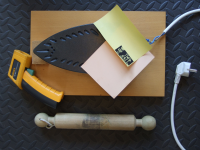 An article describes how to make a printed circuit board (PCB) using a laser printer.
An article describes how to make a printed circuit board (PCB) using a laser printer.
Making a PCB at home is quicker than having to order one and wait for delivery, reported Hackaday, and toner transfer is one of the quickest ways to do this. The circuit is printed out from a laser printer, and then the page is ironed onto copper, after which it is etched. The article said that this is great when it works, but frustrating when it doesn’t, but then offers a method that is “reliable and repeatable”.
Firstly the copper has to be cleaned of oxidation and grease, and the article suggests that the plate is then wiped clean with acetone. The transfer paper that is used can be anything from a “glossy magazine to the backing paper that peels off stickers”; and the article noted that “the point of the transfer paper is that it’s glossy so that it doesn’t deform the image, and that releases easily leaving the toner on the copper”, and for etching the advice is to use “oxygen-refreshed copper chloride in acid” because it is recyclable.
The pressure applied on the iron requires a rolling pin and full body weight: the iron at this point has the hot plate facing up, and the rolling pin is rolled over the paper, which is on top of the iron plate. The article warned that if you “roll too quickly over the board, adhesion can be uneven, so the solution is to simply go slowly and roll back and forth” for a couple of minutes.
As toner is heated up it becomes hard plastic, then becomes sticky and softer, which is when it passes through its glass phase and then due to temperature increase it becomes liquid – the goal for the transfer is to keep the toner in the “glass transition with the temperature as low as possible so that it will fuse with the copper”.
For calibration, this procedure needs to be carried out at increasing temperatures to find the optimum required for the transfer, and 130 degrees has been found to be about the right temperature for a decent transfer. This is the basic technique for printing toner PCBs, but the article does say that printer software can vary, and settings may need to be changed to develop the correct thickness of lines.
